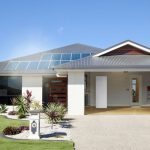Exploring Sustainable and Efficient Building Construction Through Technology
In the 21st century, technology is driving transformative changes across various industries, and the construction sector is no exception. This era has ushered in a wave of innovation that is revolutionizing the way we build. From advanced materials and renewable energy sources to smart technologies and automation, the integration of technology into building construction is paving the way for sustainable and highly efficient structures.
This article delves into the realm of modern building technology, exploring how it is shaping the future of sustainable and efficient construction.
Embracing Technological Advancements in Building Construction
Building construction has evolved significantly over the years, and technology is at the forefront of this transformation. It encompasses a broad spectrum of innovations that contribute to sustainable and efficient construction practices.
Prefabricated Components: One of the noteworthy advancements is the increased use of prefabricated components. While prefabrication is not a new concept, its popularity has surged due to its ability to reduce waste, trim labor costs, and accelerate home building project timelines. Walls, ceilings, roofs, and other structural elements can now be manufactured off-site in controlled environments using high-quality materials. This allows for swift on-site assembly, streamlining the construction process.
Automation Technologies: Automation is another game-changer in the construction industry. These technologies are designed to enhance efficiency by minimizing manual labor and improving measurement precision. Robotic arms and drones equipped with cameras, for instance, play a pivotal role in tasks such as land surveying and precise measurement, tasks that traditionally consumed significant time and human resources.
Computer-Aided Design (CAD) and Virtual Reality (VR) Systems: Architects and designers benefit immensely from CAD and VR systems. These tools provide efficient ways to visualize and plan construction projects, enabling better design accuracy and decision-making. VR, in particular, offers immersive experiences that help stakeholders gain a comprehensive understanding of the final structure before construction even begins.
Green Energy Sources: In the quest for sustainability, the construction industry is increasingly turning to green energy sources. Solar panels, wind turbines, and geothermal systems are integrated into building designs to harness renewable energy. These sources not only reduce a building’s carbon footprint but also cut down on long-term energy costs, making them economically viable.
The Rewards of Technological Integration in Construction
Utilizing technology in building construction offers a plethora of benefits that extend beyond efficiency improvements.
- Reduced Labour Costs: Automation technologies, such as robotic arms, 3D printing, augmented reality (AR), virtual reality (VR), drones, sensors, and artificial intelligence (AI), play a pivotal role in minimizing labor costs. These technologies streamline various aspects of construction, resulting in faster project completion without compromising quality. This efficiency translates to substantial cost savings, a win-win for both builders and clients.
- Increased Efficiency: Advanced technologies expedite every phase of construction, from design and planning to execution. Real-time tracking through augmented reality allows for efficient progress monitoring and swift adjustments when needed. The result is timely project completion without sacrificing safety or quality standards.
- Improved Quality: The introduction of cutting-edge technologies, such as 3D printing, contributes to improved quality in construction. Workers have access to high-quality components at a lower cost compared to traditional methods. This not only enhances the structural integrity of buildings but also extends their lifespan, reducing maintenance and repair costs over time.
In Conclusion
The integration of technology into building construction has ushered in a new era of sustainability and efficiency. By leveraging modern innovations, construction companies can create environmentally friendly structures that reduce emissions and conserve resources. Our commitment to technological advancement is key to building a sustainable future. With the right tools and resources, every building constructed in this century can be green, efficient, and safe for generations to come.
In an age where technology drives progress, embracing innovation in construction is not just an option; it’s a necessity. The future of sustainable and efficient building construction is unfolding before our eyes, and it’s an exciting journey towards a greener, more sustainable world.







